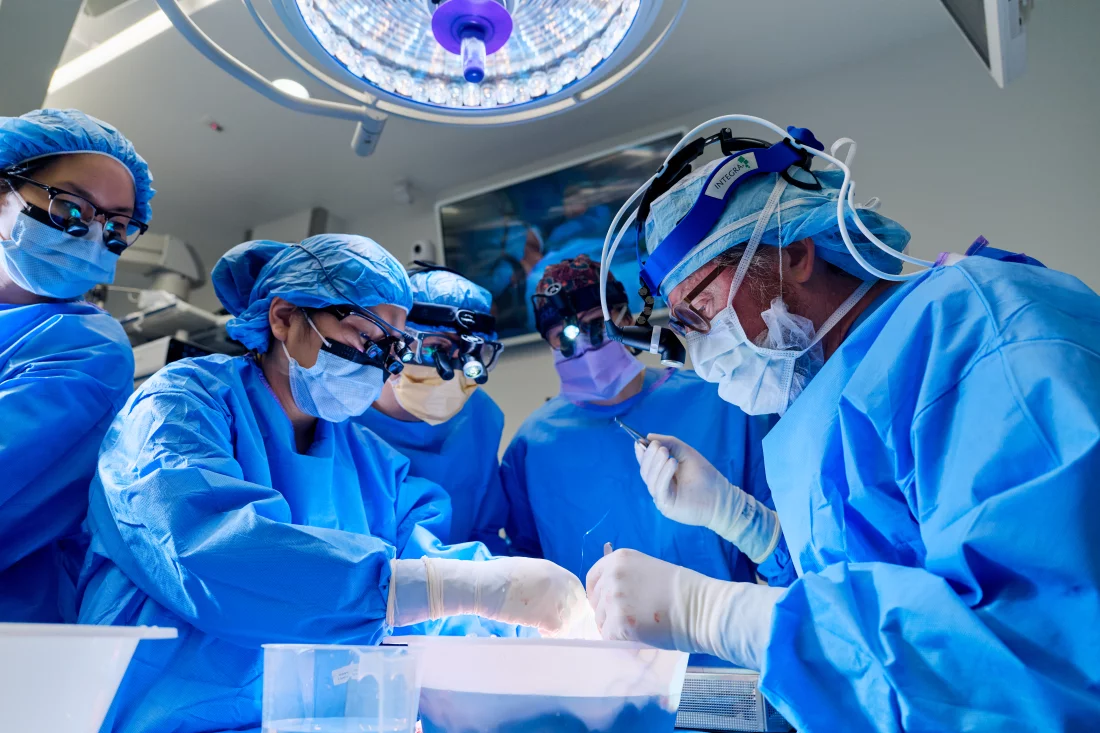 NEW YORK – Towana Looney can hardly contain her anticipation as she waits to get wheeled to an operating room at the NYU Langone Health hospital in New York City for an historic procedure.
NEW YORK – Towana Looney can hardly contain her anticipation as she waits to get wheeled to an operating room at the NYU Langone Health hospital in New York City for an historic procedure.
“It’s going to change my life,” says Looney, a 53-year-old grandmother, from Gadsden, Ala.
She volunteered to become the first living person in the world to get a kidney from a new kind of genetically modified pig. Scientists hope this kind of pig will someday provide an unlimited supply of kidneys, livers, hearts and other organs that could alleviate the chronic shortage of organs for transplantation and save thousands of patients every year.
“We’re going to make history today,” says Looney, before nurses take her in for the long, risky operation.
NPR got exclusive access to be in the operating room for Looney’s operation, which took place Nov. 25, but wasn’t announced publicly until Tuesday.
“It could completely change the management of organ failure,” says Dr. Robert Montgomery, the director of NYU Langone’s Transplant Institute, who was the lead surgeon on Looney’s operation.

Towana Looney, 53, of Gadsden, Ala., gets ready to head into the operating room at NYU Langone Health in New York City to get a genetically modified pig kidney transplant. Looney, who’s devoutly religious, says she sang church hymns the night before the surgery. But she had no doubts about trying this experimental surgery.
Joe Carrotta for NYU Langone Health
Looney was discharged earlier than expected from the hospital, but had to return for a few days to have her medication adjusted. Nevertheless, her doctors remain optimistic.
“It would change everything,” Montgomery says. “I think it would revolutionize medicine for sure.”
While many others share Montgomery’s optimism, the procedure remains controversial. Some worry the organs could spread pig viruses to people, setting off another pandemic. Others are uncomfortable with exploiting animals for their organs. Some worry about experimenting on patients desperate for any hope.
“I have many concerns,” says L. Syd M Johnson, a bioethicist at SUNY Upstate Medical University. “There’s a lot of hope, but hope is not scientific evidence. And it’s not a great way to do science — as a series of one-off experiments by different research teams, using different protocols, organs with different gene edits, and dying patients who have run out of options.”
But Looney has no qualms the day of her operation today.
“It feels like the same day that I gave my mom a kidney,” says Looney. “I’m so excited.”
Kidney failure leads patient to volunteer
Looney donated one of her kidneys to her mother in 1999. A few years later, she developed chronic high blood pressure during a pregnancy and her remaining kidney failed in 2016. Since then, she’s been on dialysis for four hours a day, three days a week.
Her immune system would reject a human kidney. So the Food and Drug Administration made an exception to its usual clinical study requirements to let her get a pig kidney that’s been genetically modified to be accepted by her body.
Even though using pig organs remains highly experimental, it’s her only chance, her doctors say.
For the same reason, the FDA previously allowed doctors to transplant two other genetically modified pig kidneys into patients in New York and Boston, as well as engineered pig hearts into two men in Maryland. Those organs seemed to work well. But the patients were gravely ill with many health problems and only survived weeks or months.
Doctors are more optimistic this time because Looney is much healthier.
“She’s in better condition than other patients who have undergone this procedure. So we’re hopeful,” Montgomery says as he scrubs in to lead the surgery. “We have an amazing team and everything’s going like clockwork.”

Dr. Robert Montgomery, who himself received a human heart transplant in 2018, leads the operation to implant a new kind of modified pig kidney into a living patient for the first time.
Joe Carrotta for NYU Langone Health
Looney is also the first living patient to receive a pig kidney with 10 genetic modifications designed to keep the organ from growing too big, being rejected and causing other complications.
“It’s a really big day. She’s a true pioneer,” says Dr. Jayme Locke. She was Looney’s doctor before moving from the University of Alabama at Birmingham to NYU. She’s assisting Montgomery today.
Pioneering operation begins
As the anesthesiologist puts Looney to sleep, Montgomery and his team get ready for the long, complicated operation.
A big screen on the wall shows the flight path of another set of surgeons. They’re flying back from rural Virginia with two kidneys from one of the cloned, gene-edited pigs being bred at a research farm run by Revivicor, a Blacksburg, Va., biotech company. NPR got exclusive access to tour the company’s facility last spring.
“Everybody ready?” Montgomery says to the surgical team. “All right.”
Montgomery makes an incision in Looney’s lower abdomen to begin painstakingly preparing a spot to implant the pig kidney.
“Scissors,” Montgomery says.
The surgeons have to find an artery and a vein to connect Looney’s blood supply to the kidney.
“There’s the artery branch,” Montgomery says. “The vein looks a little small.”
The surgeons position the kidney in her pelvis to make it easier to connect to Looney’s bladder. After more than an hour, the surgical team is finally done with that phase.
“All right, I think we’re ready,” Montgomery says.
The screen on the wall shows the helicopter approaching NYU Langone with the pig kidneys. The chopper swoops through the clear blue sky along the East River and sets down on the helipad. The arriving crew places a white box about the size of a microwave oven that contains the pig’s two kidneys on a wheelchair and rushes it to the operating room.

A surgical team flew to Revivicor’s research farm in rural Virginia and brought back two pig kidneys. Right: Surgeons measure one of the genetically modified pig kidneys before transplanted it into Towana Looney. Left: Surgeons carefully carry one kidney to Towana Looney so they can attach the organ to her blood supply and bladder.
Joe Carrotta for NYU Langone Health
“We brought both of them back — the right and the left one — so we have backup,” Montgomery says, as he removes the kidneys from two plastic bags.
“We’re not entirely sure exactly how we’re going to put them in yet until I have a look at them. The plan is to only put one in, but we may use the vessels from the other one as well,” Montgomery says.
The team then starts another long, delicate task: preparing the pig kidneys for implantation. That involves meticulously separating the kidneys, removing fat and locating the necessary veins and arteries.
“That I think is an artery,” Montgomery says at one point. “That thing in the back there.”
Finally, one of the kidneys is ready.
“OK, let’s sew this thing in,” Montgomery says.
They gingerly carry the grayish-purple kidney to Looney on the operating table and start attaching it.
“All right – we’re sewing the vein now,” Montgomery says. “I just did my side of the vein, and we’re done with the vein and we’re moving onto the artery.”
Moment of truth as blood flows into the new kidney
After they’re done stitching the kidney to the blood supply, the surgeons take a crucial step: They unclamp the artery and vein to let Looney’s blood flow into the pig organ.
“We’re about to re-perfuse. How’s her blood pressure?” Montgomery says just before taking the clamp off the vein. “You’ll see it’ll be kind of a little bit dark colored initially. And now I’m taking the clamp off the artery. It should be nice and pink.”
And that’s exactly what happens, triggering applause and cheers in the operating room.
“Beautiful,” Montgomery says. “Gorgeous. It looks beautiful. Never get tired of seeing that.”
Then comes the final step: making sure the pig kidney is doing its job — producing urine. Montgomery unclamps a tube leading out of the kidney that he’ll later attach to the bladder.
“Here we go,” Montgomery says, prompting another round of cheers and applause as urine starts gushing out. “Look at that. That is great. Look at that. Beautiful. Gorgeous. It’s just pouring out. I’m going to have wet socks tonight,” Montgomery says, laughing, as urine splashes him.

David Ayers (foreground left), chief science officers at Revivicor, of Blacksburg, Va., watches a surgical team transplant a kidney from one of the company’s genetically modified cloned pigs into a patient.
Joe Carrotta for NYU Langone Health
Finally, Montgomery turns to attaching the pig kidney to Looney’s bladder.
“Let’s finish the job,” Montgomery says. “Let’s get the plumbing done.”
Montgomery pulls off his gloves.
“Couldn’t have gone better. Could not have gone better,” he says. “We’re really pleased at this point. But you know it’s early days. It’s a big deal. But we’re off to a good start and that’s really important.”
Pig organs could alleviate the transplant shortage
Montgomery, who himself received a human heart transplant in 2018, knows there’s a lot more work to be done to see if this will work for Looney and other patients. But he’s thrilled.
“When you really think about what we just did it’s pretty amazing,” he says. “Putting a pig organ in a human being and having it work right away? You know, it’s like Star Wars stuff, right?”
More than 103,000 people are waiting for organs for transplants, and 17 die every day, according to federal statistics. Kidneys are the most-needed organs.
Looney tried other experimental procedures before this, but nothing worked. “This has been a long journey for her,” says Locke, her long-time physician. “And here she is today. I’m excited for her to get her life back.”
“It’s a super exciting day,” agrees David Ayares, president and chief scientific officer at Revivicor, who’s been waiting outside the operating room to hear how the surgery went. “Unbelievable.”
He says the company is taking extra precautions to prevent the organs from spreading any pig viruses to people. For example, everyone in the operating room was tested before surgery and will be again in four months to make sure they didn’t catch a pig virus known as porcine endogenous retrovirus or PERV.
Ayares argues the good that would come from providing enough organs for transplants outweighs the downsides of slaughtering animals.
“The goal is an unlimited supply of organs,” Ayares. “We’re trying to solve the organ shortage crisis. So having an unlimited supply of kidneys, hearts and other organs is what it’s all about.”
Ayares foresees huge farms breeding genetically modified, cloned pigs around the country to supply the organs.
Critics say a careful study is needed to rigorously evaluate the pig kidneys instead of performing these surgeries one-by-one under different conditions.
“The compassionate use experiments have been helpful in advancing the science of xenotransplantation,” says Michael Gusmano, a bioethicist at Lehigh University College of Health.
“I do have some concerns about the possibility of misinterpreting the results of these experiments. They are not research trials and are not intended to generate generalizable evidence,” he says. “The people who have received organs under compassionate use were all very sick, and it is possible that people may draw inappropriate conclusions, positive or negative, about these experiences.”
The only way to get really useful information would be to perform these procedures with more uniform conditions, some say.
“It’s difficult to draw conclusions about safety and efficacy from xenotransplants with patients who have different medical profiles,” says Karen Maschke, a bioethicist at The Hastings Center, a biomedical think tank. “It’s also difficult to draw safety and efficacy conclusions when pigs with different gene edits are used.”
Revivicor is asking the FDA to approve a formal clinical trial that could start as soon as 2025. A rival called eGenesis, of Cambridge, Mass., is also testing organs from another kind of modified pig.
Ethical and safety questions remain
In the meantime, there are ethical concerns about experimenting on desperately ill patients.
“I worry that it’s an offer patients can’t refuse because the alternative is certain death,” says Johnson, the SUNY Upstate Medical University bioethicist. “I worry about patients like that being exceptionally vulnerable and exploited, being exceptionally vulnerable to false hope.”
Johnson is also skeptical that the company is doing enough to prevent the spread of pig viruses to people. There was evidence one of the pig heart recipients got infected with a pig virus called porcine cytomegalovirus.
“It’s impossible to predict what the public health implications might be if human-to-human transmission of a pig virus happens,” Johnson says. “There’s a lot of concern right now about pigs being infected with H5N1 [bird flu]. With xenotransplantation, the risks increase because we’re potentially putting an organ that harbors a virus into a patient who is immunosuppressed.”
Johnson also worries about the pigs.
“The gene edits are not made to benefit the pigs. The gene-editing is an attempt to fit a square peg into a round hole — to sand off the incompatible edges of a pig organ to force it to work in a human. But what does that do to the pig? How does it affect their health?” she says. “The environments in which these pigs are raised for xenotransplantation necessarily deprives them of many of their basic social, psychological and physical needs.”
‘A second chance at life’
In the meantime, Looney’s new pig kidney appears to be functioning well, and her recovery is proceeding faster than expected. In fact, she was discharged from the hospital to an apartment near the hospital less than two weeks after the operation. NPR met her again there.
“I feel wonderful,” Looney says after answering the door with a wide smile. “I feel like a whole new person — like I got a second chance in life.”

Looney, with husband Willie Bennett, recovers in an apartment near the hospital. She’ll be monitored for three months before hopefully returning home to Alabama.
Rob Stein for NPR
Looney, who’s staying with her husband, Willie Bennett, will be monitored daily at the hospital for three months before hopefully heading home.
She’s enjoying cooking, being able to eat and drink a wider variety of foods and beverages, and exploring New York, although she’s being careful to avoid crowds and wears a mask. She’s taking medication to reduce her risk of rejecting the kidney, making her vulnerable to infections.
The symptoms that limited her before the operation have disappeared. “No weakness. No tiredness. No fatigue. No swelling from fluid intake. I can eat more. I can drink more. I can walk longer distances. It’s amazing,” she says. “It’s life-changing.”
She’ll never forget the first time she was able to urinate after the surgery – it was the first time she’d been able to do that in almost eight years.
“I was like, ‘Wow!’ ” she says. “I told the nurse, ‘I’m peeing!’ She said: ‘No kidding. You’re peeing a lot, which is a good thing.’ It was exciting to me.”
Looney, who’s devoutly religious, says she sang church hymns the night before the surgery. But she had no doubts. Her doctors fully explained the risks, she says, and she was unconcerned about pig viruses or other complications. She hopes the procedure will help her and other people in the future.
“Half of my family has kidney disease,” she says. “How many could this help?”
Her family and friends have been very supportive, although one friend objected to the procedure, saying “it’s not in the Bible for humans to receive animal parts,” Looney says. “I said, ‘You ate bacon this morning for breakfast didn’t you?’ ” laughing. “It’s lifesaving.’ ”
Looney’s doctors detected a blood clot in the kidney after she was discharged, but were able to flush that out with fluids. She’s staying in the hospital for a few days so doctors can administer an additional anti-rejection medication. But her kidney seems to continue function well, the hospital says.
Looney’s looking forward to returning to her job as a part-time cashier at a Dollar General, traveling and spending more time with her family, especially her two adult daughters and two grandchildren.
Being on dialysis for four hours a day, three days a week meant she could rarely travel far for long.
“I am so happy. I just feel like this is a second chance at life,” she says.
Her daughters and grandchildren plan to visit her for Christmas in the one-bedroom apartment the hospital is providing for her.
“It’s amazing,” Looney says. “It’s the best Christmas present in the world.”











